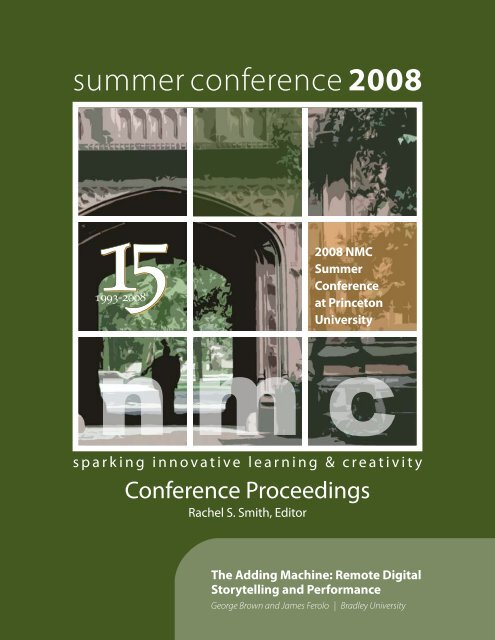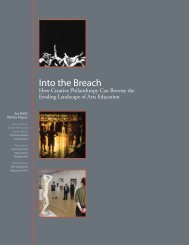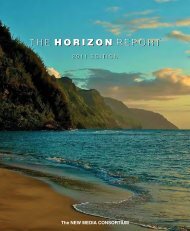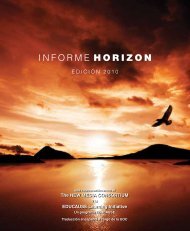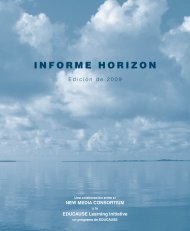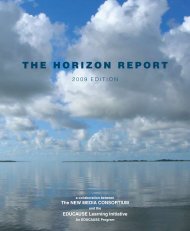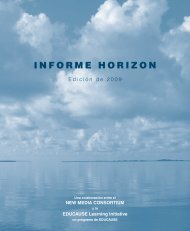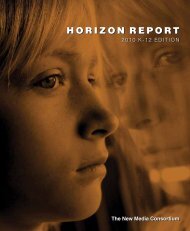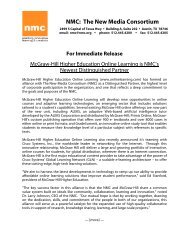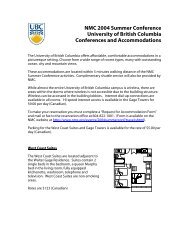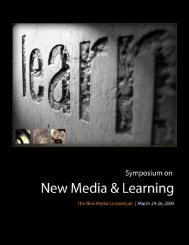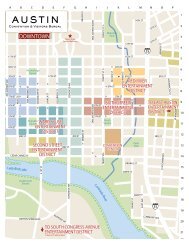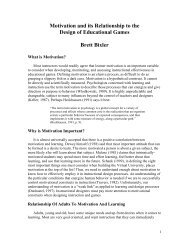summer conference 2008 - The New Media Consortium
summer conference 2008 - The New Media Consortium
summer conference 2008 - The New Media Consortium
- No tags were found...
You also want an ePaper? Increase the reach of your titles
YUMPU automatically turns print PDFs into web optimized ePapers that Google loves.
<strong>summer</strong> <strong>conference</strong> <strong>2008</strong><strong>2008</strong> NMCSummerConferenceat PrincetonUniversityn m csparking innovative learning & creativityConference ProceedingsRachel S. Smith, Editor<strong>The</strong> Adding Machine: Remote DigitalStorytelling and PerformanceGeorge Brown and James Ferolo | Bradley University
<strong>The</strong> Adding Machine:Remote Digital Storytelling and PerformanceGeorge Brown and James Ferolo | Bradley UniversityDuring March 2007, an extraordinary creative event took place that encompassed the work of three universities,four outstanding artist/administrators, over 100 student collaborators from seven academic departments, over2,000 attendees, a Pulitzer Prize winning dramatist, three high-speed advanced networks, and an unprecedentedarray of the most sophisticated rendering and communication technology ever assembled for an undergraduatetheatre production. For this event, students, faculty, and staff from the Department of <strong>The</strong>atre Arts and theMultimedia Program at Bradley University in Peoria, IL, USA collaborated with cohorts over a thousand milesaway at the University of Waterloo in Ontario, Canada and the University of Central Florida in Orlando, FL, USAto develop and present a fully mediatized production of Elmer Rice’s expressionistic play, <strong>The</strong> Adding Machine,that integrated virtual scenery, broadcast video via Internet2, recorded video, avatar performers, photographs,graphics and sound.1 <strong>2008</strong> Summer Conference Proceedings
How did it all work?Why Intermedial <strong>The</strong>atre?<strong>The</strong> Adding Machine was the latest of many intermedial productions that have been created at Bradley University andbroke through many story and technology barriers. Our goal was to create a theatrical experience that would extendbeyond the physical bounds of the Hartmann Center in Peoria and create a virtual environment that was populated byactors in locations across the country. We believed that through the use of Internet2, we could create a performancefabric that would transcend physicality and location in a significant way that also allowed us to pursue a new style ofstorytelling.Written in 1923 by Pulitzer Prize-winning playwright Elmer Rice, <strong>The</strong> Adding Machine is one of America’s first expressionisticplays. From a dystopian perspective on technology, the play takes a funny and terrifyingly expressionistic look at thedehumanization of society in a technocratic age. <strong>The</strong> play’s anti-hero, Mr. Zero, is a downtrodden wage-slave. Sackedafter 25 years’ loyal service as a bookkeeper, he murders his boss who wants to replace him with an (analog) addingmachine. He is tried and executed for his crime. After his death, Zero reaches the Elysian Fields, an idyllic countryside,unbounded by the prison walls of human conventions. But Zero has no use for unlimited freedom so he blows hischances of happiness with a devoted co-worker and opts instead to work in a “celestial repair shop” for worn out souls.<strong>The</strong>re he works diligently on a futuristic adding machine for what he expects to be eternity, but after 25 years he isagain fired and is sent back to earth, albeit with “Hope,” where he will become an even sadder cipher.In our intermedial approach to the production, Zero is ultimately viewed as a subjugate of technology who is bothimpacted by and has impact upon the technology in his life and the effect it has upon his existence. Ultimately, theplay is about choice and the technology used created a larger palette of “otherness” in a representation of heaven andhell. We believe that the use of technology in the storytelling process, particularly the use of interactive technology andremote performance, will lead to new narratives, more diverse casts, and distributed performance venues. It was thisconvergence of theatre performance, production, and dramaturgy with multimedia and streaming video technologiesthat motivated and allowed us to explore the creative potential of Internet2 in theatrical terms and achieve many otherartistic, dramaturgical, technical, and educational goals.<strong>The</strong> PlayersBradley University served as the creative center and primary performance venue for this production, where around 2000audience members watched the performance unfold. <strong>The</strong>re were two remote sites that fed telematic performances viaInternet2 and our Canadian MOU Partners (the Orion and Canarie Networks) into the primary performance venue: theUniversity of Central Florida, 1100 miles away, where John Wayne Shafer performed from his office; and the Universityof Waterloo, 800 miles away, where Brad Cook performed in a studio theatre with a wonderful technical support team.Rehearsals and production meetings for <strong>The</strong> Adding Machine were facilitated through various videoconferencingtechnologies; but for the actual performances, Digital Video Transport System, or DVTS was utilized to great success.Internet2This project truly exemplified Bradley University’s commitment tothe innovative use of Intenet2. <strong>The</strong> production team collaboratedvery closely with Chuck Ruck, Associate Provost of IRT and hisnetwork personnel who worked tirelessly to handle all thenetworking issues (at times we were pulling 120 megabits ofbandwidth during performance and rehearsal). Through theirsupport, this production became the most significant Internet2project created at Bradley to date. In <strong>2008</strong>, this production wasawarded the Internet2 Idea Award, which recognizes innovativeadvanced network applications that have had the most positiveimpact within the research and education community.2 <strong>2008</strong> Summer Conference Proceedings
DVTS and <strong>The</strong> NetworkThis project overcame two significant challenges through the use of Internet2 technologies. First was the elimination ofgeographic isolation. Internet2 and its Canadian MOU Partners (the Orion and Canarie Networks) served as the conduitfor real-time collaboration and performance. Actors in some cases actually worked in their offices without any stage orsupport crews. This non-traditional use of performance space minimized logistical demands surrounding space andsupport personnel.Secondly, the networks’ bandwidth allowed for the use of uncompressed video transmitted through Digital VideoTransport System, or DVTS, minimizing latency and heightening video quality.<strong>The</strong> integration of high quality video was an imperative for theaesthetics of this production. Actors were performing in real timefor live audiences. Without the use of Internet2, the productionwould have suffered significantly from packet loss disruptingperformances and corrupting visual elements.Additionally, this fully mediatized production pushed theenvelope in regards to performance, design, and media processes.Actors from multiple locations were synced in real time throughIsadora software and integrated into virtual environments. Thoseenvironments were created in resolutions greater than highdefinitionand were presented in matrixed displays that measured36 feet wide by 9 feet tall. To blend the real performer and scenerywith the virtual environmental and procedural animation andcompositing was utilized that would normally found in featurefilm and Broadway-type productions.In terms of networking, <strong>The</strong> Adding Machine would not have beenDVTS Bandwidth Graph. Source: http://apps.internet2.edu/dvts.htmlpossible without the extensive use of advanced networks. Dueto the high bandwidth demand for unicast DVTS, this production pulled 120 megabits of bandwidth over extendedperiods. While a single performance itself lasted only two hours, the production rehearsed 4 hours a day, six days a weekfor five weeks and the production ran for 6 performances. Total time connected via Internet2 for rehearsals, technicaldetailing and performances exceeded 100 hours. It also required significant coordination to facilitate the interaction ofthree separate university network administration systems as well as the interoperability of international partners.World Class EffortBradley University’s commitment to faculty-student interaction and interdepartmental collaboration, as well as theinstitution’s drive to discover creative uses for Internet2, helped to ensure the success of the project. In her recommendationto the Internet2 IDEA Award Committee, Ann Doyle, Manager of the Arts & Humanities Initiatives for Internet2,wrote this about <strong>The</strong> Adding Machine: “Not since Case Western Reserve’s Kinetic Shadows dance production during Internet2’s2002 Fall Member Meeting, have I seen anything as innovative in the multi-site performance genre as BradleyUniversity’s production of <strong>The</strong> Adding Machine. As Manager of Internet2 Arts & Humanities Initiatives, I am well apprisedof efforts to create a unified performance environment across multiple venues. Bradley University’s production, in additionto being visually compelling, was a remarkable collaboration of student, faculty, staff and inter-departmental expertise.<strong>The</strong> production combined virtual scenery, virtual (avatar) and live actors, sound imaging, and graphics acrossthree campuses, with live audiences and gave innovative new life to Elmer Rice’s traditional play.” She continues: “…Bradley University’s production bridged the wired/unwired gap with which institutions of higher education and facultystruggle so mightily. In this project, traditional classic canon was brought to life with cutting edge technology andadvanced networking for live audiences experiencing traditional theater-going social engagement within their communities.I suggest this project serve as a model for successfully bridging across multiple domains, honoring both thepast and creating excitement for the future.” Ann Doyle concluded her recommendation with: “It is worth noting thatBradley University is possibly the smallest student body University Member of Internet2 and has accomplished more3 <strong>2008</strong> Summer Conference Proceedings
with their Internet2 membership than many of our major research extensive campuses. It is with genuine pride thatI strongly support this nomination and encourage the IDEA Awards committee to recognize the effort and innovationbehind this amazing production.“<strong>The</strong> Design<strong>The</strong> design process was a blending of traditional scene, lighting and sound design with new media technologies. Ourgoal was to create a seamless environment that would create a compelling and engaging performance space. Erich Keilled the stage design effort and created an amazing set and accompanying design. <strong>The</strong> Hartmann Center at Bradley wasthe main venue and Erich had some significant space challenges to contend with:• No wings or fly system;• Modified thrust sightlines;• Steeply raked house;• Limited lighting resources and shop space;• Entirely undergraduate labor force; and• Need for a large projection surface on a very limitedbudget.Our solution to the physical design included:• Extending the stage out over those seats with theworst sightlines, allowing for compressed depth ofplaying space;• Walling off the upstage half of the theatre to allow forSet design by Erich Keilprojection throws without esoteric lenses;• Using Rosco Light Translucent RP which allowed for seamless integration into the scenery, high intensity for darkimages, and 160 degree viewing cone;• Compressing the space allowed for concentration of lighting equipment over a smaller area;• Placing projector angles parallel to the house aisle to minimize the appearance of hotspots;• Constructing a wall in simple sections with mullions, allowing for usage of 54” wide screen material at a significantcost savings; and• Elevating the screen from floor level to minimize washout and allow for traffic patterns backstage.Erich’s design research resulted in a set with a clearly defined visual aesthetic that could support each act and createan environment in which Zero could evolve. <strong>The</strong> industrial design split the stage into two distinct performance spaces;one on the floor that also provided an entrance and exit to the back of house through split doors, and another platformlevel that put performers on the same vertical level as the projected media. <strong>The</strong> grid of windows provided a large spanof rear projection surface for the media to play upon. <strong>The</strong> space was transformed from scene to scene and created aflexible and engaging visual set as Zero moved from life, to heaven, to hell, and ultimately back through the entire cycleagain, perhaps not having learned anything at all.Video: Set design iterations (no audio) http://media.nmc.org/<strong>2008</strong>/proceedings/set-design-iterations.movFinal set design4 <strong>2008</strong> Summer Conference Proceedings
Zero, Daisy, and Mrs. ZeroZero confronts “<strong>The</strong> Boss”Zero kills “<strong>The</strong> Boss”Zero becomes an “Adding Machine”Zero is awakened in the crypt by a hooker and her johnZero and Daisy in the Elysian Fields5 <strong>2008</strong> Summer Conference Proceedings
<strong>Media</strong> Design<strong>The</strong>re was a distinct stage of research and production while creating <strong>The</strong> Adding Machine that led us through a seriesof visual concepts that matured in tandem with the skills of the students who worked on the production. During theFall semester, co-creators George Brown and Jim Ferolo worked with both theatre arts and multimedia students ona variety of visual tests combined with table read-throughs of the script. <strong>The</strong> process was documented by studentsand posted to a project website that can be found at http://addingmachine.bradley.edu. <strong>The</strong> earlier conceptual workprovided a “safe sandbox” where students and faculty alike could try new technologies and see how they wouldintegrate with the text. Nearly fifteen students worked on the research phase.Video: Design and research (no audio) http://media.nmc.org/<strong>2008</strong>/proceedings/design-and-research.movDesign was completed over the Winter Holiday Break in 2006 and mediaproduction began the first week of the Spring semester in January 2007.Green screen shoots for still and motion graphics sequences were the firstactivities and provided crucial visual elements related to story plot points.All production was completed within studios at Bradley University onextremely limited sets using HDV and Canon20D cameras for acquisition.<strong>Media</strong> production elements were driven by a variety of originally createdimages, public use image databases (Morguefile, Prelinger Archives) andpublic domain imagery. Image types included video and still sources,composites built in Final Cut Pro and After Effects, 2D/3D CGI created inAfter Effects and Maya.Picture editorial was completed in Final Cut Pro with motion graphicscompositing in After Effects. <strong>The</strong> jury scene shows a composite of twelve performances from only 2 cast members.<strong>The</strong> jury sceneArchitectural CGI elements were modeled and animated in Maya. This scene shows the entrance to the crypt whereZero has awoken with another corpse.Video: Entrance to the crypt (no audio) http://media.nmc.org/<strong>2008</strong>/proceedings//ferolo/cryptintro.mov6 <strong>2008</strong> Summer Conference Proceedings
Scenes of Elysian Fields (Zero’s Heaven) were designedand rendered as procedural environments using Vue.<strong>The</strong> software, while computationally expensive, is visuallystunning. We used, modified, and credited pre-built stockscenes due to time constraints as show deadlines loomed.<strong>The</strong> post-production team regularly processed rendersinto the early morning hours and ended using nearlyfifty computers in a “sneaker-net” render farm at BradleyUniversity.VUE software running a tree simulationPlayback and Display Systems<strong>Media</strong> was integrated into the production through the use of projection surfaces, live cameras, and DVTS feeds allintegrated through a DV switcher and Isadora show control software that was created by TroikaTronix (see http://www.troikatronix.com/isadora.html).Generally, there were three types of media inputs and one displayarea on the main stage. Incoming sources included pre-composedCGI and composites, DVTS feeds from Waterloo and Florida, and liveDV feeds from studio spaces in Peoria. Overall, there were six PCsused for synchronous DVTS locations, one Mac Pro running Isadorafor switching, and another show control PC for non-media housesound. Audio offsets were compensated for within the switcher.Generally, there were three types of media inputs and one displayarea on the main stage. Incoming sources included pre-composedCGI and composites, DVTS feeds from Waterloo and Florida, and liveDV feeds from studio spaces in Peoria. Overall, there were six PCsused for synchronous DVTS locations, one Mac Pro running Isadorafor switching, and another show control PC for non-media housesound. Audio offsets were compensated for within the switcher.Playback and display diagramStudent operators Lee Flayton (left) and Dave Rogers (right)operate Isadora and DV switcher respectively7 <strong>2008</strong> Summer Conference Proceedings
IsadoraEach individual scene required a different Isadora patching setup toaccommodate the various sources and live keying components. Isadorais an object-based visual patching system that allows for an incredibleamount of flexibility in design and application approaches. However,there were ultimately (3) video outputs from the Isadora system that fedthe projection system, regardless of the number of inputs.All input signals were matrixed together into a single 2400x800 pixelraster (a raster is essentially the overall pixel dimensions of the displayedimage).<strong>The</strong> full raster was built from three 800x600 display outputs running at24fps. Composites were built at the full 2400x800 pixel size in After Effects,rendered in uncompressed format, and finally split into 3 distinct videoBasic Isadora patching testfiles (left, center, right) using Compressor and Animation as a CODEC. <strong>The</strong>Mac Pro contained a Raid 5 array that provided the disc throughput and data security needed for the show. We foundthat there was a slight delay in the right video card because of clock sync issues between the two video cards that werein the Mac Pro. Manual offsets were used to align playback, however, sync errors continually surfaced and were nevercompletely eliminated.Studio feed in PeoriaRaw DVTS Feed from Orlando before live compositingSound Issues<strong>The</strong> one DVTS issue that plagued us was sound due to the creation of audio loops. A performer at a remote site wouldspeak into a microphone. That signal was streamed the 1000 miles to the performance site at Bradley via the DVTS.That signal was then amplified and broadcast though our house sound system so both the actors and audience couldhear it. With this basic system design, the microphones at Bradley that were used to pick up our actors voices to sendthem to the remote sites also picked up the amplified voices creating a sound loop that repeatedly echoed across thecontinent. This issue was solved technically by having the actors in the remote sites use ear buds to break the loop(they still heard themselves, though) and then, with the assistance of local sound expert Rand Kuhlman, we utilizedan array of audio compressors and gates to eliminate the problematic loops by making the microphones at Bradleysound-canceling. <strong>The</strong> solution worked sufficiently that the audience in Peoria did not notice a problem but again,the performers “acted” over several sound problems. Hours of telematic rehearsals helped ensure show timing andexecution. Additionally, many of the performances were backed up by an emergency bat-phone connection that waskept open between stage managers at the various locations to troubleshoot and cue, as needed.8 <strong>2008</strong> Summer Conference Proceedings


